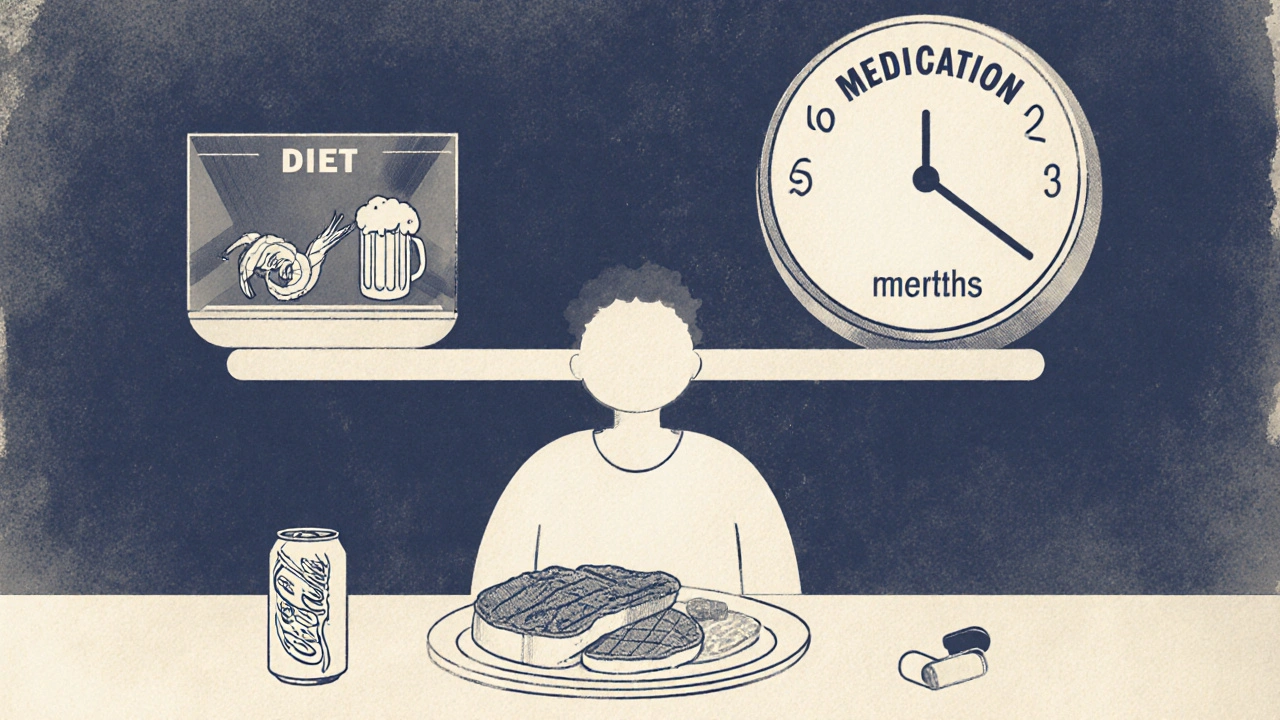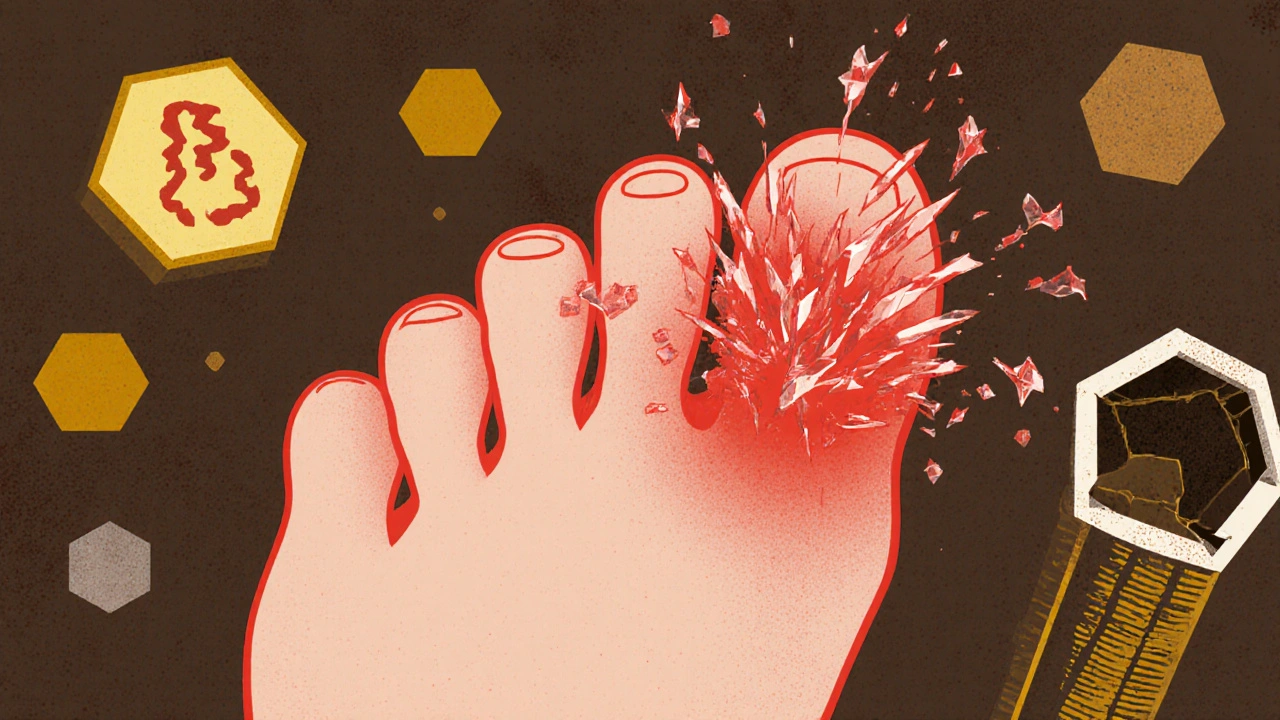When your big toe suddenly swells up, turns red, and feels like it’s on fire-even the lightest sheet can feel unbearable-you’re not just having a bad night. You’re experiencing a gout flare. And behind that pain is a hidden biochemical storm: your body can’t properly handle purines, and uric acid crystals are building up in your joints. This isn’t just about diet or drinking too much beer. It’s about how your body breaks down food, how your kidneys filter waste, and whether the right medications are being used at the right doses.
What Happens When Purines Go Wrong
Purines are natural substances found in your cells and in certain foods. When your body breaks them down, it produces uric acid. In most people, that uric acid dissolves in the blood, gets filtered by the kidneys, and leaves the body in urine. But in people with gout, something goes off track. The problem isn’t always that you’re eating too many purine-rich foods. It’s that your body either makes too much uric acid or can’t get rid of it fast enough. About 90% of gout cases are due to under-excretion-not overproduction. Your kidneys reabsorb up to 90% of the uric acid they filter, thanks to transporters like URAT1 and GLUT9. If those are overactive, uric acid builds up. And here’s the kicker: humans lost the enzyme uricase millions of years ago. Most animals break down uric acid into allantoin, which is easy to flush out. We don’t have that safety net. So even small imbalances in purine metabolism can lead to crystals forming in joints, triggering inflammation, swelling, and extreme pain.When Uric Acid Becomes a Problem
The medical threshold for hyperuricemia is 6.8 mg/dL-the point at which uric acid starts to crystallize in your joints. But numbers alone don’t tell the whole story. A 2015-2016 NHANES study showed that at levels below 6 mg/dL, only 0.7% of people had gout. At 9 mg/dL or higher? Nearly 28% did. That’s why treatment isn’t just about lowering the number-it’s about getting it low enough to dissolve existing crystals and prevent new ones. The American College of Rheumatology recommends keeping serum uric acid below 6.0 mg/dL for most patients, and below 5.0 mg/dL if you have visible tophi (those chalky lumps under the skin). Yet, only about 37% of gout patients in the U.S. ever reach that target. Why? Because many doctors start treatment too low, don’t increase the dose, or stop medication too soon after a flare clears up.The Three Types of Urate-Lowering Medications
There are three main classes of drugs used to lower uric acid-and each works differently.Xanthine Oxidase Inhibitors (XOIs): Stop Production at the Source
These are the first-line treatment for most people. They block xanthine oxidase, the enzyme that turns xanthine into uric acid. Allopurinol has been around since the 1960s. It’s cheap-generic versions cost just $4.27 a month-and effective. But here’s the catch: most people take too little. The FDA-approved starting dose is 100 mg a day. But studies show that 92% of patients reach their target when the dose is titrated up to 300 mg or higher. Many doctors never go beyond 200 mg, leaving patients stuck with high uric acid levels. Febuxostat, approved in 2009, is stronger and doesn’t need dose adjustment for kidney issues. It hits target levels in about two-thirds of patients. But it comes with a black box warning from the FDA after the CARES trial found higher heart-related deaths compared to allopurinol-especially in people with existing cardiovascular disease.Uricosurics: Help Your Kidneys Flush It Out
These drugs block the URAT1 transporter in your kidneys, so less uric acid gets reabsorbed and more gets excreted. Probenecid is one of the oldest uricosurics, approved in 1949. It works well if your kidneys are healthy (creatinine clearance above 50 mL/min), but it’s useless if you have kidney disease. It also requires multiple daily doses and can cause kidney stones. Lesinurad was approved in 2015 but pulled from the market in 2019 because of serious kidney damage. It was only ever used in combination with allopurinol, and even then, the risks outweighed the benefits for most people.Uricase Agents: Break Down Uric Acid Completely
Pegloticase is the nuclear option. It’s an IV infusion that converts uric acid into allantoin-the same harmless compound other animals naturally make. It’s incredibly effective: 42% of patients reach target levels within six months, and many see tophi shrink or disappear entirely. But it’s not for everyone. It costs over $16,000 a month. It requires premedication to prevent severe allergic reactions. And it’s only approved for people with severe, treatment-resistant gout. One Reddit user said it took 17 insurance appeals just to get it covered.
Why Many People Stop Taking Their Medication
You’d think that with these options, gout would be under control. But the Gout & Uric Acid Education Society found that 61% of patients stop their urate-lowering therapy within a year. Why? Three big reasons:- 33% think it’s not working-often because they didn’t wait long enough. It takes months for crystals to dissolve.
- 29% have side effects-rash from allopurinol, liver enzyme spikes from febuxostat.
- 18% find the dosing confusing-multiple pills, frequent blood tests, titration schedules.
Diet Matters, But Not Like You Think
Yes, organ meats, anchovies, and beer are high in purines. Liver has 240-400 mg per 100 grams. Anchovies? 500 mg. Beer contains 10-20 grams of purines per liter. But here’s the truth: even if you cut out every high-purine food, your uric acid will only drop by 1-2 mg/dL. That’s not enough to get most people to target. Diet helps-but it’s not the cure. Medication is. The bigger dietary issue? Fructose. High-fructose corn syrup, soda, sweetened juices-these trigger uric acid production. One 2004 study showed that drinking just one sugary soda a day increased gout risk by 85%.
The Future of Gout Treatment
New drugs are on the horizon. Verinurad, a selective URAT1 inhibitor, is in Phase III trials. When combined with febuxostat, it helped 74% of patients reach target levels in just 12 weeks. Arhalofenate, a dual-action drug that lowers uric acid and reduces inflammation, cut flare frequency by 58% in a 2024 trial. Researchers are also looking at genetic markers like SLC2A9 variants, which affect how well your kidneys handle uric acid. In the future, we may be able to match patients to the right drug based on their DNA. But until then, the best strategy is simple: start low, go slow, and go high enough. If allopurinol isn’t working at 300 mg, talk to your doctor about increasing it-or switching to febuxostat if you’re not at risk for heart disease. Don’t quit because of a flare. Don’t stop because it’s expensive. And don’t rely on diet alone.What You Can Do Today
- If you’ve been diagnosed with gout, ask for a serum uric acid test. Know your number.
- If you’re on allopurinol and not at target, ask if you can increase the dose-up to 300 mg or even 400 mg if your kidneys allow it.
- If you’re on febuxostat and have heart disease, talk to your doctor about risks.
- Start colchicine if you’re beginning urate-lowering therapy-even if you’re not having flares.
- Limit sugary drinks and alcohol. Eat less red meat and organ meats. But don’t think cutting out shrimp will fix your gout.
- Get your uric acid checked every 2-5 weeks until you hit target, then every 6 months.
Frequently Asked Questions
Can gout be cured?
Gout can’t be permanently cured, but it can be completely controlled. With consistent urate-lowering therapy and keeping serum uric acid below 6.0 mg/dL, crystals dissolve over time, flares stop, and joint damage halts. Many people live years without a single flare once they’re on the right dose.
Why does my gout flare up when I start taking allopurinol?
When uric acid levels drop quickly, crystals in the joints begin to dissolve, which triggers inflammation. This is a sign the drug is working-not failing. That’s why doctors recommend taking colchicine for at least six months when starting treatment to prevent these flares.
Is febuxostat safer than allopurinol?
It depends. Febuxostat is more effective at lowering uric acid and works better in people with kidney disease. But the FDA issued a black box warning after the CARES trial showed a higher risk of heart-related death in people with existing cardiovascular disease. Allopurinol is safer for heart patients and is still the first choice for most.
How long does it take for tophi to disappear?
Tophi dissolve slowly. With consistent treatment and uric acid levels below 5.0 mg/dL, you might see improvement in 6-12 months. Complete dissolution can take 1-3 years. Pegloticase works faster-some patients see tophi shrink in 3-6 months-but it’s only for severe cases.
Do I need to take these medications forever?
Yes. Gout is a chronic condition caused by your body’s inability to handle uric acid. Stopping medication-even if you feel fine-lets uric acid rise again, crystals reform, and flares return. Lifelong treatment is the standard of care for most patients.


Nathan Hsu
So, let me get this right: humans lost uricase, and now we’re stuck with gout? That’s like evolution saying, "Oops, we forgot the off-switch!" I mean, we invented the internet, but we can’t fix our own biochemistry? I’m just saying… we’re kinda screwed. And yes, I’m using six exclamation points because I’m Indian and we don’t do half-measures!!!